

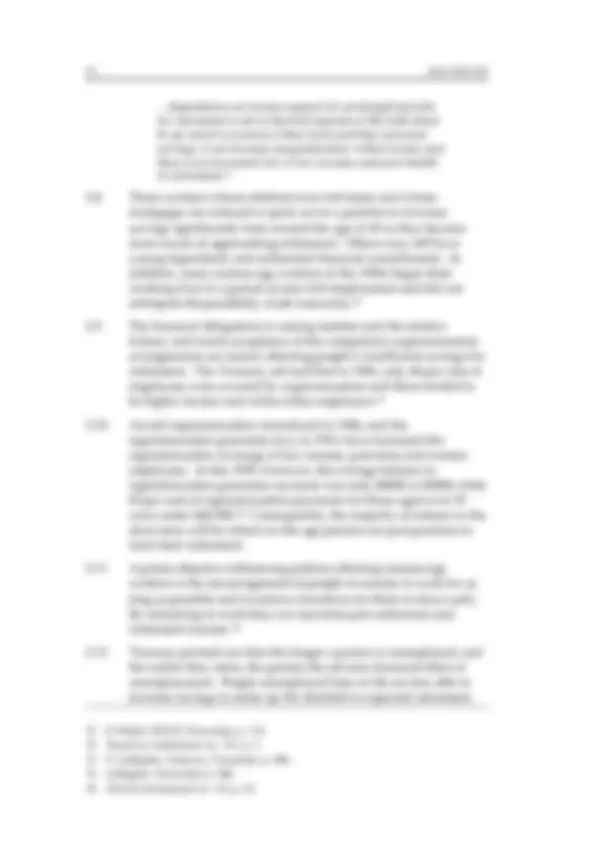
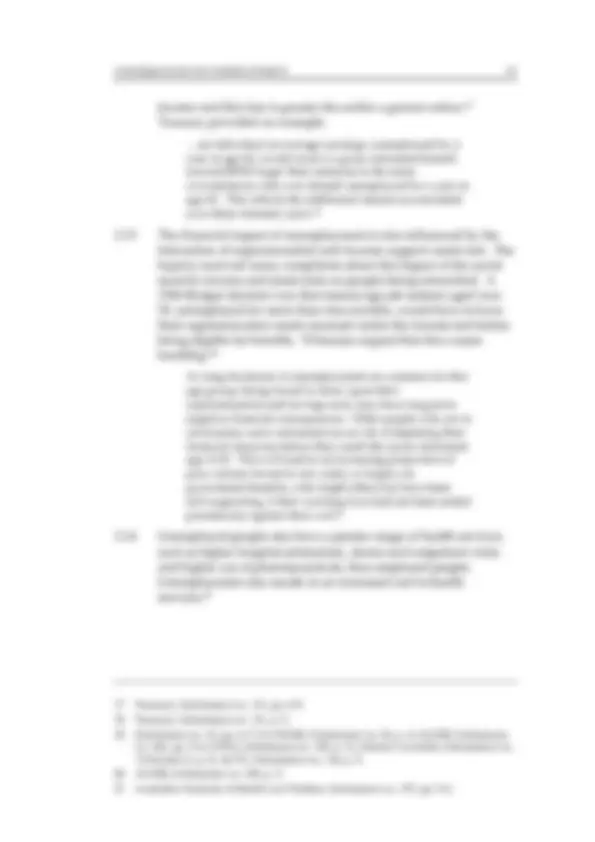
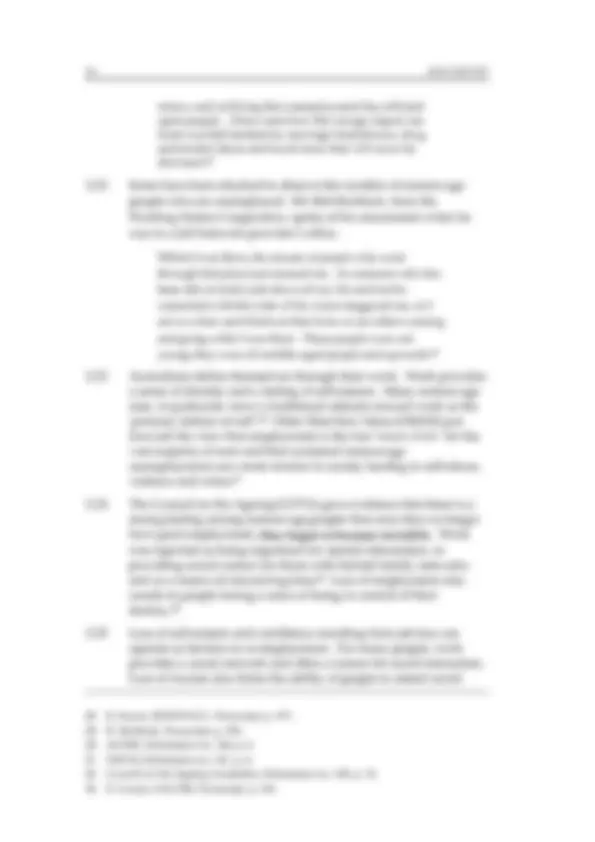
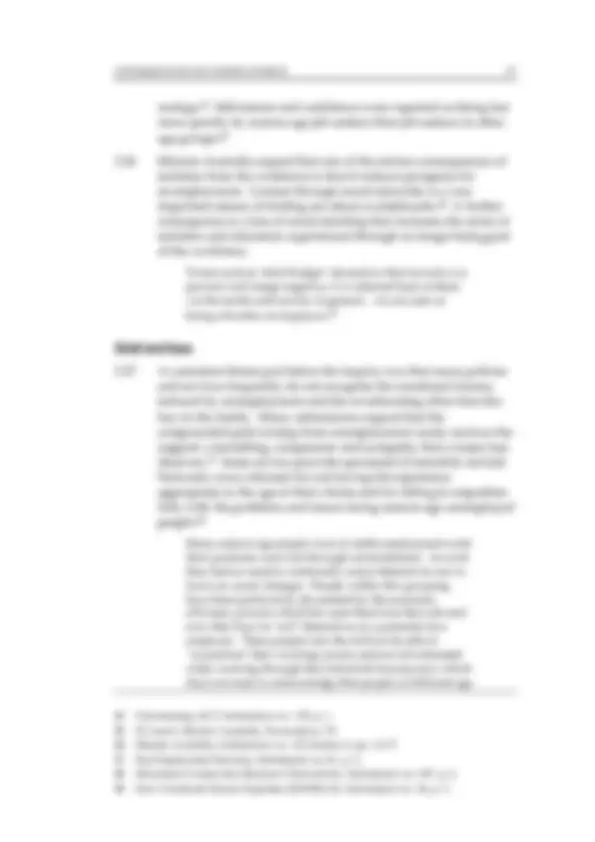
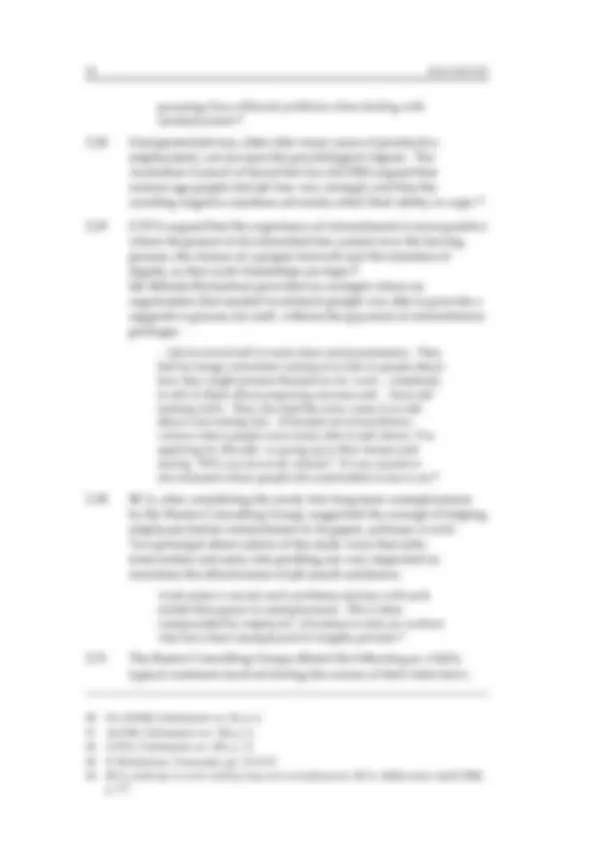
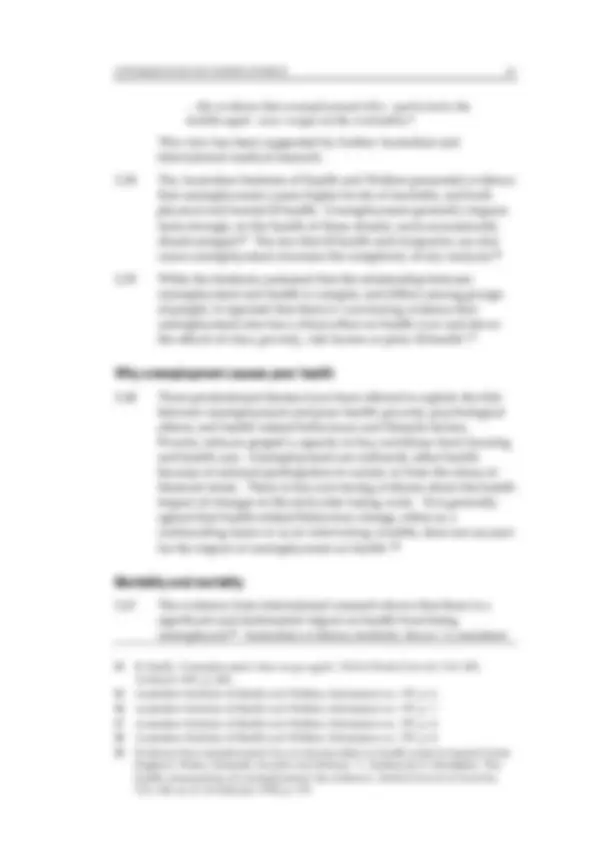
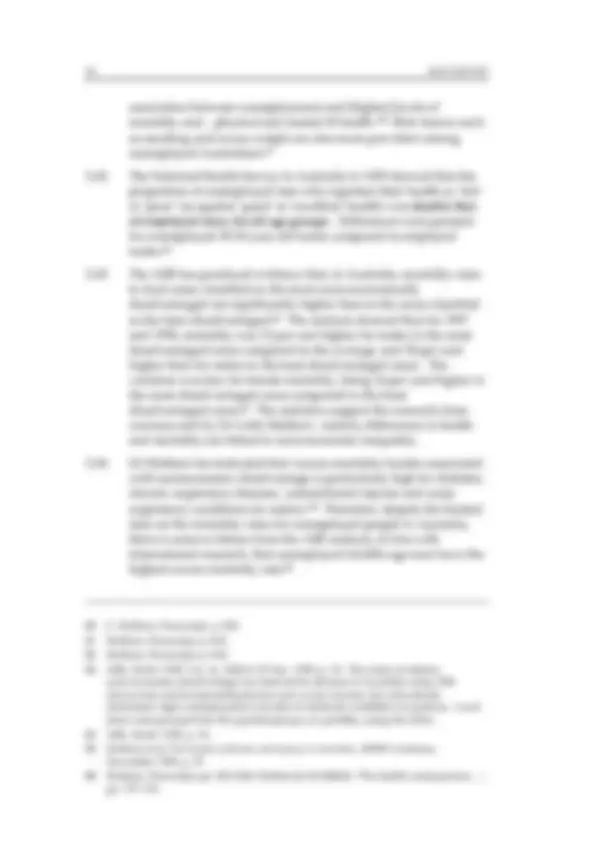
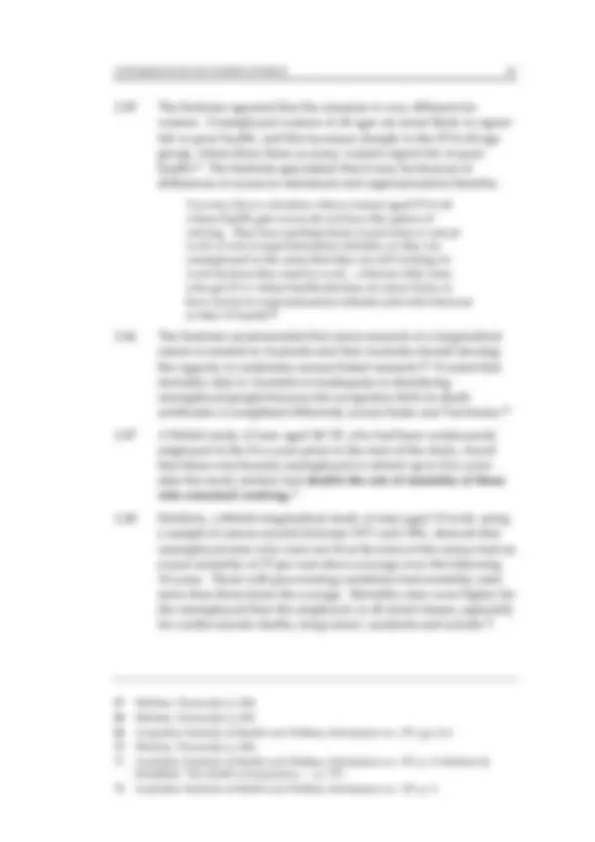
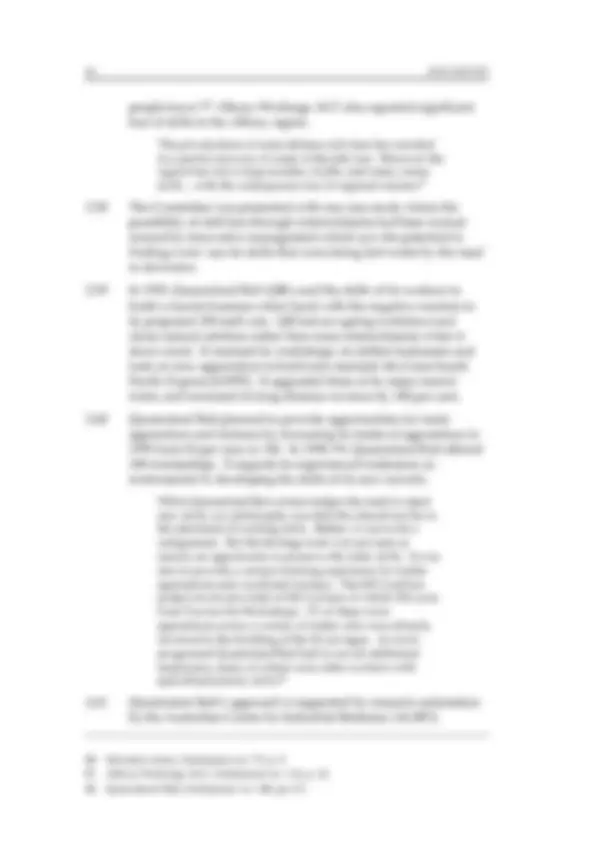

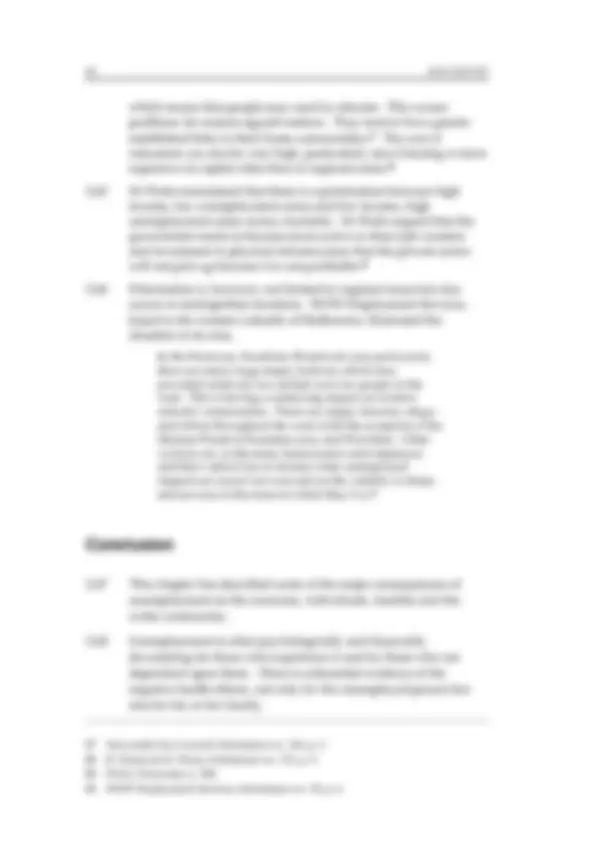




Study with the several resources on Docsity

Earn points by helping other students or get them with a premium plan


Prepare for your exams
Study with the several resources on Docsity

Earn points to download
Earn points by helping other students or get them with a premium plan
Community
Ask the community for help and clear up your study doubts
Discover the best universities in your country according to Docsity users
Free resources
Download our free guides on studying techniques, anxiety management strategies, and thesis advice from Docsity tutors
Quite apart from the personal impact, unemployment is a loss of valuable productive resources to the economy. The impact of job.
Typology: Study Guides, Projects, Research
1 / 22

This page cannot be seen from the preview
Don't miss anything!















…growing old’s like being increasingly penalised for a crime you haven’t committed.
(Anthony Powell, Temporary Kings: a Novel , Heinemann, London, 1973, p. 3)
2.1 Unemployment is a major life event. It can have a devastating impact on people’s lives. It affects not just the unemployed person but also family members and the wider community. The impact of unemployment can be long-lasting. As unemployment becomes more long-term, its impact becomes more far reaching, often affecting living standards in retirement. The loss of income by the parents can damage the prospects of the next generation.
2.2 Quite apart from the personal impact, unemployment is a loss of valuable productive resources to the economy. The impact of job loss in rural and regional areas flows through the local community damaging businesses as family expenditure is reduced. Further damage to local communities may result from people leaving in search of work.
2.3 The financial, budgetary and economic effects of unemployment are profound. Many of those who leave the workforce unwillingly do not have the resources for a comfortable and long retirement. The price paid by society is increased income support, health and community support costs and reduction in human capital and
50 AGE COUNTS
productivity.^1 Entrenched unemployment results in a divided nation where those with jobs benefit from economic growth while those missing out may be relegated to secondary status.^2
2.4 The economic loss to the individual and the family cannot be overstated. The Treasury advised that in the short-term, unemployment significantly reduces a person’s income and, in the long-term, reduces their ability to save for retirement and other goals. This is because employer as well as employee superannuation contributions are lost and the capacity to save from disposable income is lowered.^3 One witness gave a personal example of some of the financial difficulties faced:
The stress levels of just finding money to pay the utility accounts every quarter are never ending. No sooner is one utility account paid off in instalments than the next quarter's accounts are due and you have to repeat the process of pleading with people from the utilities to allow you to pay that account in instalments as well. Home maintenance tends to suffer because there are no spare funds for painting, parts replacements or general up-keep. Any major incidents (burst water pipes, etc) mean getting the work done and then arranging instalments to pay off the account, and, when added to utility instalment arrangements, means less disposable money to pay for food and basic living costs. What I find is that the longer I am out of work the greater is my level of compounding debt. Even having to buy a printing cartridge for my printer (to enable me to prepare this submission) has set me back a further $55 which comes at the expense of something else.^4
2.5 Mission Australia reported they had clients who were unable to afford suitable clothing for interviews, a telephone, or transport to interviews.^5 Pep Employment Services argued that the lack of financial support for home owners/purchasers who are unable to pay their council rates often causes hardship. They argued that in
1 COTA, Submission no. 109, p. 3. 2 Hume City Council, Submission no. 118, p. 14. 3 Treasury, Submission no. 131, pp. 1, 13. 4 Submission no. 32, p. 6. 5 Mission Australia, Submission no. 110, Section 2, p. 17.
52 AGE COUNTS
…dependence on income support for prolonged periods for retirement is not in the best interests of the individual. It can result in erosion of their skills and their personal savings, it can increase marginalisation within society and there is an increased risk of low incomes and poor health in retirement.^12
2.8 Those workers whose children have left home and whose mortgages are reduced or paid, are in a position to increase savings significantly from around the age of 45 as they become more aware of approaching retirement. Others may still have young dependants and substantial financial commitments. In addition, many mature-age workers in the 1990s began their working lives in a period of near full employment and did not anticipate the possibility of job insecurity.^13
2.9 The financial obligations in raising families and the relative infancy and recent acceptance of the compulsory superannuation arrangements are factors affecting people’s insufficient savings for retirement. The Treasury advised that in 1986, only 40 per cent of employees were covered by superannuation and these tended to be higher income and white-collar employees.^14
2.10 Award superannuation, introduced in 1986, and the superannuation guarantee levy in 1992, have increased the superannuation coverage of low income, part-time and women employees. In late 1999, however, the average balance in superannuation guarantee accounts was only $8000 or $9000 while 82 per cent of superannuation payments for those aged over 55 were under $40 000.^15 Consequently, the majority of retirees in the short term will be reliant on the age pension (or part pension) to fund their retirement.
2.11 A prime objective influencing policies affecting mature-age workers is the encouragement of people to remain in work for as long as possible and to remove incentives for them to leave early. By remaining in work they can maximise pre-retirement and retirement income. 16
2.12 Treasury pointed out that the longer a person is unemployed, and the earlier they retire, the greater the adverse financial effect of unemployment. People unemployed later in life are less able to increase savings to make up the shortfall in expected retirement
12 B. Wight, DFaCS, Transcript, p. 116. 13 Treasury, Submission no. 131, p. 3. 14 P. Gallagher, Treasury, Transcript, p. 486. 15 Gallagher, Transcript, p. 486. 16 DFaCS, Submission no. 115, p. 22.
CONSEQUENCES OF UNEMPLOYMENT 53
income and this loss is greater the earlier a person retires.^17 Treasury provided an example: …an individual on average earnings, unemployed for a year at age 64, would receive a gross retirement benefit around $9500 larger than someone in the same circumstances who was instead unemployed for a year at age 45. This reflects the additional interest accumulated over these nineteen years.^18
2.13 The financial impact of unemployment is also influenced by the interaction of superannuation and income support assets test. The inquiry received many complaints about the impact of the social security income and assets tests on people being retrenched. A 1996 Budget decision was that mature-age job seekers aged over 55, unemployed for more than nine months, would have to have their superannuation assets assessed under the income test before being eligible for benefits. Witnesses argued that this causes hardship.^19 As long durations of unemployment are common for this age group, being forced to draw upon their superannuation and savings early may have long-term negative financial consequences. Older people who are in involuntary early retirement are at risk of depleting their financial resources before they reach the usual retirement age of 65. This will lead to an increasing proportion of poor retirees forced to rely solely or largely on government benefits, who might otherwise have been self-supporting, if their working lives had not been ended prematurely against their will.^20
2.14 Unemployed people also have a greater usage of health services, such as higher hospital admissions, doctor and outpatient visits and higher use of pharmaceuticals, than employed people. Unemployment also results in an increased cost to health services.^21
17 Treasury, Submission no. 131, pp. 4-5. 18 Treasury, Submission no. 131, p. 5. 19 Submission no. 32, pp. 6–7; SA DOME, Submission no. 36, p. 4; ACOSS, Submission no. 106, pp. 5–6; COTA, Submission no. 109, p. 21; Mission Australia, Submission no. 110-Section 3, p. 8; ACTU, Submission no. 136, p. 5. 20 ACOSS, Submission no. 109, p. 5. 21 Australian Institute of Health and Welfare, Submission no. 157, pp. 5-6.
CONSEQUENCES OF UNEMPLOYMENT 55
2.19 The Australian Catholic Social Welfare Commission summarised the impact of unemployment on mature-age people. The psychological and social costs of retrenchment and prolonged unemployment during the productive years of life impact harshly on the quality of life of affected individuals and families. Experiences of low self-esteem and loss of self identity impact on physical and mental health and can extend to broader consequences of social isolation and the loss of social networks and support. The impact of redundancy causes family disruption and breakdown. At the very least it reduces people’s sense of membership and contribution to the life of the community.^26
2.20 Supporting this observation were vivid illustrations witnesses gave the Committee, of the devastating effects unemployment has on mature-age workers, especially on men over 45. Mr Bryson Dyke at the Brisbane hearing said:
I know people who have been put out of work, and they begin to act like 15-year-olds. It is just not a good time to start addressing some of the life changing problems. For example, a lot of my colleagues have fallen into the trap of stepping out and saying, ‘Okay, I am going to show them that I am a good worker and that I can do it. I am going to start my own business.’ It is a sort of knee-jerk reaction to what is basically a grieving process, and it is no wonder that a number of those businesses go broke.^27
2.21 Another witness, Ms Kathleen Boyne, who managed the Mature Workers Program for five years in Bega, gave a graphic example of the impact unemployment had on the unemployed and their families. For 11 years I have been working directly with unemployed people at the grassroots level in training and case management. I have seen, heard and felt the human
26 Australian Catholic Social Welfare Commission, Submission no. 117, p. 5. See also the effects on males from non-English speaking backgrounds. K. Talty, Transcript, pp. 935–936. 27 B. Dyke, Transcript, p. 646.
56 AGE COUNTS
misery and suffering that unemployment has inflicted upon people…I have seen how this savage impact can foster suicidal tendencies, marriage breakdowns, drug and alcohol abuse and much more that will never be disclosed.^28
2.22 Some have been shocked to observe the number of mature-age people who are unemployed. Mr Bob Mortlock, from the Working Nation Cooperative, spoke of his amazement when he was in a Job Network provider’s office.
Whilst I was there, the stream of people who went through that place just amazed me. As someone who has been able to hold a job down all my life and not be connected with this side of life, it just staggered me, as I sat in a chair and filled out that form, to see others coming and going while I was there. These people were not young; they were all middle-aged people and upwards.^29
2.23 Australians define themselves through their work. Work provides a sense of identity and a feeling of self-esteem. Many mature-age men, in particular, have a traditional attitude toward work as the ‘primary definer of self’.^30 Older Men:New Ideas (OM:NI) put forward the view that employment is the last ‘ raison d’etre’ for the vast majority of men and that sustained mature-age unemployment can create tension in society leading to self-abuse, violence and crime.^31
2.24 The Council on the Ageing (COTA) gave evidence that there is a strong feeling among mature-age people that once they no longer have paid employment, (^) they begin to become invisible. Work was reported as being important for mental stimulation, in providing social contact for those with limited family networks and as a means of structuring time.^32 Loss of employment also results in people losing a sense of being in control of their destiny.^33
2.25 Loss of self-esteem and confidence resulting from job loss can operate as barriers to re-employment. For many people, work provides a social network and often a reason for social interaction. Loss of income also limits the ability of people to attend social
28 K. Boyne, SENSWACC, Transcript, p. 871. 29 R. Mortlock, Transcript, p. 926. 30 ACOSS, Submission no. 106, p. 6. 31 OM:NI, Submission no. 141, p. 4. 32 Council on the Ageing (Australia), Submission no. 109, p. 10. 33 E. Carson, SACOSS, Transcript, p. 361.
58 AGE COUNTS
groupings have different problems when dealing with unemployment.^40
2.28 Unexpected job loss, often after many years of productive employment, can increase the psychological impact. The Australian Council of Social Service (ACOSS) argued that mature-age people feel job loss very strongly and that the resulting negative emotions adversely affect their ability to cope.^41
2.29 COTA argued that the experience of retrenchment is more positive where the person to be retrenched has control over the leaving process, the chance of a proper farewell and the retention of dignity so that work friendships are kept.^42 Ms Belinda Richardson provided an example where an organisation that needed to retrench people was able to provide a supportive process for staff, without the payment of retrenchment packages. …[it] involved staff in motivation and presentation. They had an image consultant coming in to talk to people about how they might present themselves for work…somebody to talk to them about preparing resumes and …basic job seeking skills. They also had the army come in to talk about overcoming fear…It became an extraordinary culture where people were freely able to talk about, ‘I’m applying for this job,’ or going up to their bosses and saying, ‘Will you act as my referee?’ It was a positive environment where people felt comfortable to move on.^43
2.30 BCA, after considering the study into long-term unemployment by the Boston Consulting Group, supported the concept of helping employees before retrenchment in its paper, pathways to work. Two principal observations of the study were that early intervention and early risk profiling are very important to maximise the effectiveness of job search assistance. A job seeker’s morale and confidence decline with each month that passes in unemployment. This is then compounded by employers’ reluctance to take on workers who have been unemployed for lengthy periods.^44
2.31 The Boston Consulting Group offered the following as a fairly typical comment received during the course of their interviews:
40 SA DOME, Submission no. 36, p. 6. 41 ACOSS, Submission no. 106, p. 6. 42 COTA, Submission no. 109, p. 13 43 B. Richardson, Transcript, pp. 212-213. 44 BCA, pathways to work: tackling long-term unemployment , BCA, Melbourne, April 2000, p. 15.
CONSEQUENCES OF UNEMPLOYMENT 59
Employment services are optimised while the employee is still employed. The pressure is off, they are earning and their self-esteem is still on board. Gaining employment assistance prior to retrenchment means you can go through the process with your mates, with encouragement from your peers. Once they've been retrenched they are so isolated and distant from their peers.^45
2.32 The Committee was told of cases where unemployment had affected family relationships (see also Chapter 1). Much of the disturbance or stress placed on relationships was attributed to the changing of the breadwinner role between partners, which for mature-age couples, is often traditionally held by males. The Salvation Army Employment Plus argued that ‘changed relationships within the family and the fact that one member of the family now spends more time at home with no clearly defined role’ can lead to frustration and resentment.^46 Albury-Wodonga ACC made a similar assertion. A feeling of depression sets in and they tend to display a lot of anger towards society. Wives, partners and families are left to cope with a “changed person”. Recent research indicates that the cause of a substantial number of divorces and relationship break-ups in the 40 and over age group can be traced back to the male losing his job and his perceived role as the main provider for the family.^47
2.33 Mission Australia reported that unemployment of the male puts pressure on the partner to seek employment. Where the male has been the main breadwinner and the woman has been out of the workforce for a lengthy period, she may face significant barriers in returning to work.^48 The male more frequently being the main breadwinner often creates a poverty trap, as wives of unemployed men also tend to be unemployed.^49
2.34 One story was particularly disturbing to the Committee:
45 L. Kamener, Boston Consulting Group, Transcript p. 806. 46 The Salvation Army Employment Plus, Submission no. 73, p. 4. 47 Albury-Wodonga ACC, Submission no. 114, p. 13. 48 Mission Australia, Submission no. 110, Section 3, p. 7 citing S. Encel, & H. Stendnecki, (1995), Job Search Experience of Older Workers , NSW Consultative Committee on Ageing, Sydney. 49 Mission Australia, Submission no. 110, Section 3, p. 3.
CONSEQUENCES OF UNEMPLOYMENT 61
…the evidence that unemployment kills—particularly the middle-aged—now verges on the irrefutable.^54 This view has been supported by further Australian and international medical research.
2.38 The Australian Institute of Health and Welfare presented evidence that unemployment causes higher levels of mortality and both physical and mental ill health. Unemployment generally impacts most strongly on the health of those already socio-economically disadvantaged.^55 The fact that ill health and incapacity can also cause unemployment increases the complexity of any analysis.^56
2.39 While the Institute cautioned that the relationship between unemployment and health is complex and differs among groups of people, it reported that there is ‘convincing evidence that unemployment also has a direct effect on health over and above the effects of class, poverty, risk factors or prior ill-health’.^57
2.40 Three predominant themes have been offered to explain the link between unemployment and poor health: poverty; psychological effects; and health related behaviours and lifestyle factors. Poverty reduces people’s capacity to buy nutritious food, housing and health care. Unemployment can indirectly affect health because of reduced participation in society or from the stress of financial strain. There is less convincing evidence about the health impact of changes in life-style after losing work. ‘It is generally agreed that health-related behaviour change, either as a confounding factor or as an intervening variable, does not account for the impact of unemployment on health.’^58
2.41 The evidence from international research shows that there is a significant and detrimental impact on health from being unemployed.^59 Australian evidence similarly shows ‘a consistent
54 R. Smith, ‘Unemployment: here we go again’, British Medical Journal , Vol. 302, 16 March 1991, p. 606. 55 Australian Institute of Health and Welfare, Submission no. 157, p. 6. 56 Australian Institute of Health and Welfare, Submission no. 157, p. 1. 57 Australian Institute of Health and Welfare, Submission no. 157, p. 8. 58 Australian Institute of Health and Welfare, Submission no. 157, p. 8. 59 Evidence that unemployment has an adverse effect on health exists in research from England, Wales, Denmark, Sweden and Finland. C. Mathers & D. Scholfield, ‘The health consequences of unemployment: the evidence’, Medical Journal of Australia , Vol. 168, no. 4, 16 February 1998, p. 179.
62 AGE COUNTS
association between unemployment and [higher] levels of mortality and…physical and mental ill health.’^60 Risk factors such as smoking and excess weight are also more prevalent among unemployed Australians.^61
2.42 The National Health Survey in Australia in 1995 showed that the proportion of unemployed men who reported their health as ‘fair’ or ‘poor’ (as against ‘good’ or ‘excellent’ health) was double that of employed men, for all age groups. Differences were greatest for unemployed 45-54 year old males compared to employed males.^62
2.43 The ABS has produced evidence that, in Australia, mortality rates in local areas classified as the most socio-economically disadvantaged are significantly higher than in the areas classified as the least disadvantaged.^63 The analysis showed that for 1997 and 1998, mortality was 12 per cent higher for males in the most disadvantaged areas compared to the average, and 30 per cent higher than for males in the least disadvantaged areas. The variation was less for female mortality, being 16 per cent higher in the most disadvantaged areas compared to the least disadvantaged areas.^64 The statistics support the research done overseas and by Dr Colin Mathers: namely differences in health and mortality are linked to socio-economic inequality.
2.44 Dr Mathers has indicated that ‘excess mortality burden associated with socioeconomic disadvantage is particularly high for diabetes, chronic respiratory diseases, unintentional injuries and acute respiratory conditions (in males).’^65 Therefore, despite the limited data on the mortality rates for unemployed people in Australia, there is some evidence from the ABS analysis, in line with international research, that unemployed middle-age men have the highest excess mortality rate.^66
60 C. Mathers, Transcript, p. 823. 61 Mathers, Transcript, p. 823. 62 Mathers, Transcript, p. 824. 63 ABS, Deaths 1998 Cat. no. 3302.0, 29 Nov. 1999, p. 33. The index of relative socio-economic disadvantage was derived for all areas in Australia using 1996 census data and incorporating factors such as low income, low educational attainment, high unemployment and jobs in relatively unskilled occupations. Local areas were grouped into five graded groups, or quintiles, using the index. 64 ABS, Deaths 1998 , p. 33. 65 Mathers et al, The burden of disease and injury in Australia , AIHW Canberra, November 1999, p. 37. 66 Mathers, Transcript, pp. 823–824; Mathers & Scholfield, ‘The health consequences…’, pp. 179–181.
64 AGE COUNTS
Mental health
2.49 The research on mental health supports the anecdotal evidence put to the inquiry about the psychological distress suffered by mature-age job seekers. The Australian Institute of Health and Welfare reported that mental health studies show that psychological health is worse for the unemployed. In a USA study, unemployed men aged 35-60 had higher levels of depression and anxiety than those who were employed. A German study found higher levels of depression and anxiety and that these regressed with re-employment or formal retirement.^73
2.50 The evidence suggests that the impact of unemployment on mental health is dependent on the social support systems available at the time. In Britain, stress among men was lower in areas of high unemployment than in areas of low unemployment. The Australian Institute speculated that people may have adapted better to unemployment because of their support networks and because the cost of living is lower in higher unemployment areas.^74 In areas of low unemployment, the stigma often associated with unemployment may be less evident since unemployment is more widespread and its psychological impact is lessened.
2.51 Australian evidence in 1995 showed that children without an employed parent had 26 per cent more serious chronic illnesses, visited the doctor 20-30 per cent more often and made twice as many outpatient visits compared to children of employed parents.^75 Caution must be used, however, in interpreting this data since the relationship between cause and effect is complex.
2.52 While few studies have examined the effects of unemployment on others in the family, there is some evidence from a study in England and Wales that mortality rates are 20 per cent higher for wives of unemployed men. Unemployment also results in a higher risk of separation and divorce, domestic violence, unwanted pregnancy, increased peri-natal and infant mortality, poorer infant growth and increased use of health services.^76
73 Australian Institute of Health and Welfare, Submission no. 157, p. 3. 74 Australian Institute of Health and Welfare, Submission no. 157, pp. 3-4. 75 Australian Institute of Health and Welfare, Submission no. 157, p. 7. 76 Australian Institute of Health and Welfare, Submission no. 157, p. 7.
CONSEQUENCES OF UNEMPLOYMENT 65
2.53 Unemployment also has consequences for the wider community. Not only is there a greater reliance on income support but the skill level of workers who have difficulties getting another job may fall, which is a loss to the economy. The health consequences of unemployment result in a greater strain on the health system. Regional and rural areas may experience particularly severe economic upheaval.
2.54 A significant disadvantage suffered by mature-age job seekers is that their skills tend to be lost over time, particularly as they are more likely to experience longer periods unemployed. These skills are also lost to the labour market and industry. JOFA argues that this loss has to a large extent not been measured.^77 However, some of these skills would have become obsolete as technological and industrial changes have resulted in new skills being required. It is becoming more important in the modern workplace for existing skills to be upgraded and for new skills to be acquired.
2.55 Unfortunately, many mature-age job seekers do not have access to training to enable them to develop and acquire skills. Even within employment there is evidence that older workers have less access to training. The ACTU submitted that: …research produced for the NSW Office on Ageing and by the University of Queensland shows many workplaces appear to be denying older workers the chance to learn and progress in their careers. These studies show older workers often receive lower levels of training and retraining, and have lower promotion rates.^78
2.56 The Association of Independent Retirees noted that:
…skills in particular areas could be lost completely if there was a run-down of a particular business or industry or if retrenchment occurred through…takeover and subsequent re-establishment overseas.^79
2.57 The Salvation Army Employment Plus reported that ‘increasingly we are noticing a loss of skills/knowledge to industry when older
77 Job Seeking Over Forty Association (JOFA), Submission no. 94, p. 11. 78 ACTU, Submission no. 136, p. 3. 79 Association of Independent Retirees, Submission no. 51, p. 2.
CONSEQUENCES OF UNEMPLOYMENT 67
reported by the ACTU, which found that workplaces have become more productive where they have adopted a positive approach to integrating mature aged workers’ skills and experiences.^83 QR's renaissance in passenger business had already given the organisation a new image as a dynamic and progressive railway business. The GSPE was a logical step in building upon this image and also as an opportunity to capitalise on the high level skills that had died out in other railways.^84
2.62 The impact of unemployment is often more strongly felt in regional economies owing to their smaller scale. Submissions from organisations based in regional Australia indicated that restructuring had significant flow-on effects for their economies. The main streets of Albury and Wodonga have a number of vacant premises which have closed their doors…the vacant premises have remained vacant. Major retail outlets have either not renewed their leases or have drastically reduced the hours of both permanent and casual staff further reducing employment opportunities.^85
2.63 The Australian Workers’ Union (AWU) pointed to the flow-on effects of unemployment in the area from the Hawkesbury River to Coffs Harbour and the Hunter Valley. The AWU reported that mainly low skilled or basic trade-skilled people were casualties of downsizing and closures across a wide range of industries. Many people were also being made redundant from ancillary service industries in the manufacturing sector. The immense problems that the coal industry has faced up here has had a dramatic flow-on to a lot of smaller engineering and maintenance companies. They are the ones and twos that do not make the media and no-one ever hears about unless you are closely related to someone, and there are dozens and dozens of those ones and twos just closing up every day.^86
2.64 Chapter 1 shows that duration of unemployment is significantly greater for mature-age job seekers living in non-metropolitan areas. Problems of unemployment are exacerbated in regional areas because most employment growth has been in capital cities
83 ACTU, Submission no. 136, p. 2. 84 Queensland Rail, Submission no. 140, p. 2. 85 Albury-Wodonga ACC, Submission no. 114, p. 14. 86 K. Maher, AWU, Transcript, p. 957.
68 AGE COUNTS
which means that people may need to relocate. This causes problems for mature-age job seekers. They tend to have greater established links in their home communities.^87 The cost of relocation can also be very high, particularly since housing is more expensive in capital cities than in regional areas.^88
2.65 Dr Watts maintained that there is a polarisation between high income, low unemployment areas and low income, high unemployment areas across Australia. Dr Watts argued that the government needs to become more active in direct job creation and investment in physical infrastructure that the private sector will not pick up because it is not profitable.^89
2.66 Polarisation is, however, not limited to regional areas but also occurs in metropolitan locations. WOW Employment Services, based in the western suburbs of Melbourne, illustrated the situation in its area. In the Footscray/Sunshine/Braybrook area particularly there are many large empty factories which once provided relatively low-skilled work for people in the west. This is having a continuing impact on western suburbs’ communities. There are empty factories, shops and offices throughout the west (with the exception of the Moonee Ponds to Essendon area, and Werribee). Older workers are, in the main, homeowners and ratepayers and their radical loss of income when unemployed impacts on council services and on the viability of shops and services in the areas in which they live.^90
2.67 This chapter has described some of the major consequences of unemployment on the economy, individuals, families and the wider community.
2.68 Unemployment is often psychologically and financially devastating for those who experience it and for those who are dependent upon them. There is substantial evidence of the negative health effects, not only for the unemployed person but also for his or her family.
87 Newcastle City Council, Submission no. 143, p. 2. 88 R. Dennis & M. Watts, Submission no. 172, p. 9. 89 Watts, Transcript, p. 944. 90 WOW Employment Services, Submission no. 35, p. 6.